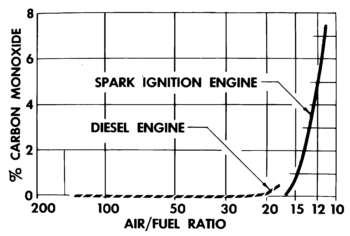Diesel Exhaust

Diesel-engine exhaust gases are claimed by numerous witnesses – including during the trial against John Demjanjuk in 1987 – to have been used to mass-murder Jews in the camps at Belzec, Sobibór and Treblinka, and in some of the so-called gas vans. However, diesel-engine exhaust gas is notoriously low in its most toxic component, carbon monoxide (CO), and relatively high in oxygen, as compared to gasoline-engine exhaust gas (ignoring the effect of catalytic converters, which didn’t exist during World War II; see the chart).
While diesel-engine exhaust gases are lethal in the long run, they are unsuitable for killing within short periods of time, as claimed by witnesses. Experiments conducted with small mammals, using exhaust from a diesel engine rigged in the most extreme way to produce a maximum amount of CO, have demonstrated that it takes up to five hours of full exposure to the pure exhaust gasses in order to kill all individuals (Pattle et al. 1957). Since small mammals succumb to CO poisoning faster than humans, such a system could never have been used for a swift mass murder.
German engineers were fully aware of the CO contents in exhaust gases of various engine types, and in particular of diesel engines, so they would have known which engine to pick, if they had intended to commit murder (Mattogno/Graf 2023, pp. 121-125). Due to their relatively innocuous nature, diesel engines were deployed in coal mines around the world, as their exhaust gases could be vented into the mines without doing much harm (Berg 2003; Rudolf 2024a, pp. 442-444). As one report put it (Gilbert 1974, p. 403):
“An examination of all safety records has revealed that no person has suffered any harmful effects either temporarily or permanently as a direct result of breathing any toxic gas emitted from any vehicle powered by a diesel engine.”
More importantly, due to extreme shortage of any petroleum-based fuel in wartime Germany, the entire German road-transportation industry, incentivized by government decrees and subsidies, switched from liquid fuel to gas by installing so-called producer-gas or wood-gas generators on trucks, buses, vans and even tanks. These devices produce a gas rich in CO, which is then burned in the engine as fuel – unlike in a gasoline or diesel engine, where CO is a waste product. The CO gas is produced by partial combustion of various wet fuels (wood, coal, coke). Every German vehicle engineer knew about them during the war. They were easy to procure, cheap to operate, had endless fuel, and their gas would have been instantly lethal. In fact, the Germans even developed a method of exterminating warm-blooded vermin with this technology, which was very common to combat mouse and rat infestations of freight ships. But there are no reports of any of them ever having been misused for murder. (See the section “Carbon-Monoxide Fumigation” of the entry on fumigation gas chambers.)
Facing the impossibility of committing mass murder with Diesel-engine exhaust gases, some orthodox scholars now deny that any serious researchers still claims that any such gassings ever occurred (see e.g. Morsch/Perz 2011, p. 34), insisting instead that gasoline engines were used, although the evidence for Treblinka and Belzec clearly refutes that claim. Those camps likely did have stationary diesel engines, but they would have been used to drive electrical generators, not to kill people.

You need to be a registered user, logged into your account, and your comment must comply with our Acceptable Use Policy, for your comment to get published. (Click here to log in or register.)